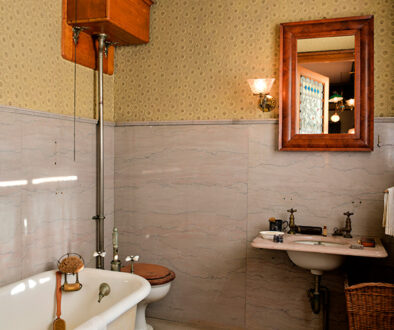Victorians and Majolica
Cape May is steeped in Victorian architecture, furnishings, art, and so much more. Although trends towards Victorian furniture have waned over the years, the lively, colorful, and often whimsical Majolica pottery has held steady with collectors. With every subsequent year, Majolica ownership continues to attract new enthusiasts.
The Victorian age began with Queen Victoria’s reign from 1837 until her death in 1901. In Victorian society, emphasis was placed on morality, and this prudence was reflected by its citizens’ very choices in architecture, art, furnishings, and clothing. With the influx of Europeans settling in the United States and bringing their Victorian values with them, a friendship was forged between President Buchanan and Queen Victoria. With a growing educated middle class, forms of expression from their art down to their leisure activities began to take precedent.
In 1851 the first World’s Fair, known as the Great Exhibition, was held in Hyde Park, London. Showcased were early innovations, all housed in a grand glass structure. Majolica pottery was exhibited at the Minton stand (part of Staffordshire pottery) which later became a worldwide success. Based on 15th-century Italian maiolica—a tin-glazed artform—majolica became the 19th-century version. Majolica went against established norms of stodgy Victorian sensibilities with its whimsical, brightly colored pottery, often incorporating botany and zoology, along with satirical subjects.

The French ceramicist, Leon Arnoux, employed by Minton, developed a tin glaze together with in-glaze metallic oxide enamels first used in the factory. He also developed the lead glazes and kiln technology necessary to create lively Majolica pieces. This helped streamline the process, and the factory could now mass-produce the ceramics. Minton marketed the ware in two categories: naturalistic and historical. The popularity of acquiring this exceptional pottery surged, and currently these are among the pieces that have held the most value.
Vases, jardinières, pitchers, candy dishes, tureens, decorative art, you name it—majolica was now the trend. Everyone just had to own a piece. No longer was pottery strictly for utilitarian use, but was now used to make a statement. Not every citizen carried the black-cloaked traditions of Queen Victoria. They wanted modernity, bright colors, an expression of individuality as a component of their personality. The unusual fusion of 19th-century trends—naturalism, revivalism, exoticism and more—was in this unique pottery. The mania of owning a piece continued until the turn of the century.
A high-relief trout or a lobster platter may be used as a fanciful decoration either perched on a stand or hung on a wall, often evoking discussion of its meaning. The dead fish or the cooked lobster could be interpreted as man’s predatory nature. Yet, not all were meant as a statement, but combined art with functionality. A compote shaped like a rabbit may have been meant to hold the contents of a flourless rabbit pie.
There were revolving tiered oyster stands with two dozen ceramic half shells to support an opened oyster—a rare treat due to overfishing at the time with oysters at astronomical costs. And what a way to present this culinary luxury to your guests in such an esthetically pleasing vessel! If you’re lucky to discover such a piece, consider this a great find but be prepared to pay upwards of five figures. Although this is an extreme, there are many more affordable pieces to fit your budget.
With the popularity of majolica, other companies produced their own version, using the same techniques. Wedgwood and George Jones began to produce pottery from 1850 to 1900. Keep this in mind when shopping for pieces; the runners-up may just be available. Majolica can be found in antique shops, auction houses, and online companies like eBay.

A Wedgwood piece I acquired decades ago is identified by the organic design and vibrant cobalt blue, along with its unique markings. High-end makers rarely leave the piece unmarked and reproductions don’t come close to achieving such fine workmanship. Today the vibrant colors cannot be replicated because of the lead use in the paint and glazes, along with the firing technique. Do keep in mind that Wedgwood majolica is still being produced today. So, keep searching for an authentic piece.
When trying to date your piece, turn it over and study the back. The dish is marked; Wedgwood (used since 1769) and includes a 3-digit date code POZ, with the last letter indicating the year made (Z = year 1897).
Values for such pieces can range from $500 to $800. Recently I have seen this piece listed for $1200. The price disparity depends on rarity, and how blemish-free and sought-after the piece is. The more organic the design, along with the color palette, will command the price. In this example, muted green and brown is often used in less expensive pieces but surpassed by the cobalt blue color. Add the organic grape leaves and its branches acting as handles, combined with the detailed basket weave, and the value increases.
This piece is far too nice to be used as a dish for holding grapes and can be deadly because of the lead component. So, for a collector, an original piece of majolica is meant as a work of art to be displayed for all to see. And naturally placed far from little meddling hands!



